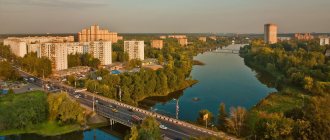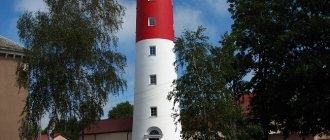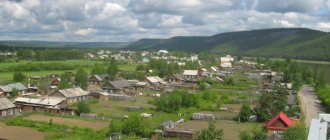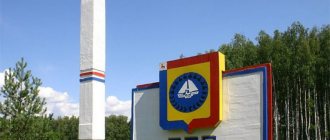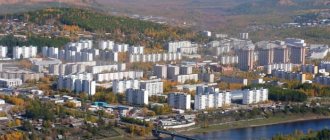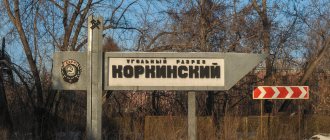The city of Aldan is located in South Yakutia. It is also a center for gold mining and the development of mica deposits. In 2016, 20,892 people lived in it, and the largest number of residents was recorded in 2002, when their number reached 24,715 people. The national composition of the city, settlements and the entire ulus is represented by Russians, Yakuts, Evenks and other nationalities.
Etymology
It arose as a mining village at a large gold deposit discovered in 1923, and was named Nezametny. In 1939 it was transformed into a city and was renamed Aldan from the hydronym of the Aldan River. The question of the etymology of the hydronym continues to be controversial. According to E.M. Pospelov, the widespread version of the origin from the Turkic-Mongolian “altan, altyn” - “gold” is not confirmed, since the peoples who lived on the banks of this river either did not know gold, or “altan” could not be used in their languages turn into "Aldan". As a hypothesis, Pospelov admits that “Aldan” (variant “Allan”) may be associated with the Evenk “oldo, ollo” - “fish”, that is, “fish river”[2].
All data taken from Wikipedia website
Where is Aldan?
It is located on the Amur-Yakutsk railway. The city has a civil regional airport. Communication is carried out only with the airport in the city of Yakutsk. The distance Yakutsk - Aldan is 530 km. The airport accepts light and medium aircraft, for example, the Yak-40 can land and take off. The runway is 1376 meters long and 35 meters wide.
In the immediate vicinity of the airport there are 4 hotels, including the Victoria mini-hotel, and a parking lot. Airplanes arrive and depart quite rarely, with an interval of approximately 5 days. Several roads run from and through Aldan. There is a bus connection with Yakutsk along the Lena highway. The most important highway is the AYAM, which is sometimes called the “Great Trail”.
Story
Coat of arms 1984
According to the official version, the city’s birthday is considered to be June 19, 1923, when a free prospector, Yakut M.P. Tarabukin, panning for gold with a small artel, and Latvian V.P. Bertin, who headed the first labor artel, met at the Nezametny stream, where a mine with the same name was founded.
According to official statistics, Aldan (formerly Nezametny) began his chronicle in 1923. All anniversary years are counted from this date.[1].
On September 20, 1932, the village of Nezametny received city status, and in May 1939 it was renamed the city of Aldan.
In the 1990s, the city experienced a demographic crisis; However, in the period from 2000 to 2010, people began to come to the city again, commercial aviation and a railway station appeared. Also, between 2009 and 2010, the city began construction of an oil pipeline branch, which significantly influenced the economic development of the city.
Economy
Typical Aldan is the center of gold mining, although the mines are located at a distance from it. From time to time it is called the “Russian Klondike”, since the region annually gives the country tens of tons of gold. The most common type of business is mining cooperatives. In addition to gold, mica is also mined in the ulus. The woodworking industry is also developed. There are also metalworking enterprises. In 2009-10, construction of an oil pipeline began, which had a positive impact on the economic development of the entire ulus.
Geographical position
Located on the Aldan Highlands, in the basin of the Aldan River (the right tributary of the Lena), at the confluence of the Orto-Sala River and the Nezametny Stream, 530 km south of Yakutsk. The city, like the entire Aldan region, is located on the Aldan shield. The oldest crystalline rock formations with an age of more than 3 billion years come to the surface.
The city is located in an area with the richest natural resources: deposits of coal, iron ore, apatite and uranium ores are located next to the Small BAM railway line, which was opened for traffic on December 19, 1992. It should soon stretch to Yakutsk.
Geological exploration work carried out on the Aldan-Stanov shield [2] confirmed the presence of large reserves of copper, uranium, mica and large deposits of iron ores, as well as polymetals and gold in the Charo-Tokkinskoye, Yuzhno-Aldanskoye and Sutamskoye deposits. The Aldan Shield also hosts the world's only deposit of charoite.
The use of the unique mineral resource base of the region opens up great prospects in industrial terms, which, in turn, will entail the development of the infrastructure of the city and the region.
Location and climatic conditions
Aldan on the map of Russia is located in the southwest of the city of Yakutsk. It stands on the Orto-Sala River, which belongs to the Aldan River basin, at its confluence with the Nezametny Creek. The city is located on that part of the Aldan Highlands, which is called the shield. A characteristic feature is the emergence of ancient crystalline formations from the earth layer.
The area where the city is located belongs to areas with a sharply continental climate. However, it is somewhat softer than in Yakutsk or Neryungri. Usually in winter the temperature is 25 °C. The absolute minimum is 48 °C. Summers are cool and the average temperature is about + 22 °C. However, the warmth lasts from May to the end of August. This brings the climatic conditions closer to those present in the Central Russian Upland, hence the opportunity to grow many garden and vegetable crops: potatoes, cucumbers, tomatoes and the like.
Population[edit | edit code]
| Population | ||||||||
| 1939[3] | 1959[4] | 1967[5] | 1970[6] | 1979[7] | 1989[8] | 1992[5] | 1996[5] | 1998[5] |
| 14 022 | ↘12 358 | ↗15 000 | ↗17 689 | ↗20 173 | ↗27 090 | ↘26 400 | ↘24 000 | ↘22 900 |
| 2000[5] | 2001[5] | 2002[9] | 2003[5] | 2005[5] | 2006[5] | 2007[5] | 2008[5] | 2009[10] |
| ↘21 500 | ↘21 200 | ↗24 715 | ↘24 700 | ↘24 300 | ↘24 000 | ↘23 900 | ↘23 800 | ↘23 486 |
| 2010[11] | 2011[12] | 2012[13] | 2013[14] | 2014[15] | 2015[16] | 2016[17] | 2017[18] | 2018[1] |
| ↘21 275 | ↘21 227 | ↗21 673 | ↘21 538 | ↘21 364 | ↘21 092 | ↘20 892 | ↘20 700 | ↘20 595 |
As of January 1, 2022, in terms of population, the city was in 672nd place out of 1115[19] cities of the Russian Federation[20].
Culture and attractions
An Orthodox church was built between 1995 and 2000. Since 1933, the city has had a local history museum, which tells about the nature of the region, its antiquity and the development of gold mining. Apart from the monument to the discoverers of gold, this is the only attraction.
Everything else in Aldan is the ordinary reality of a provincial town in the south of Yakutia. However, the city is rich in natural resources. Views of the taiga open directly from the windows of the houses. At a distance of about 200 km from it, the territory of the Olekminsky nature reserve begins. On the coast of the Olekma River flowing through the reserve there are sites and burial grounds of ancient people of the Neolithic period.
The Aldan city website was created through the efforts of enthusiasts and is a forum with a news section.
Climate
Aldan has a sharply continental climate, which is much milder than in Yakutsk: it is much warmer in winter and cooler in summer, with three times more precipitation. Winters are moderately cold, with slight temperature fluctuations from month to month. From December to February, thaws are excluded.
| Climate of Aldan | |||||||||||||
| Index | Jan. | Feb. | March | Apr. | May | June | July | Aug. | Sep. | Oct. | Nov. | Dec. | Year |
| Absolute maximum | −2,5 | −1 | 9,1 | 15,5 | 27,4 | 34,3 | 34,4 | 35,2 | 25,8 | 16,7 | 6,1 | −0,6 | 35,2 |
| Average maximum, °C | −21,9 | −18,1 | −9,3 | 0,9 | 10,6 | 20,3 | 22,6 | 19,2 | 9,8 | −2,4 | −14,6 | −21,3 | −0,3 |
| Average temperature, °C | −26,3 | −23,3 | −15,2 | −4,2 | 5,1 | 13,9 | 16,6 | 13,4 | 4,9 | −6,4 | −18,8 | −25,3 | −5,5 |
| Average minimum, °C | −30,6 | −28,3 | −21,3 | −9,6 | 0,0 | 7,5 | 10,9 | 8,1 | 0,8 | −10,4 | −23,1 | −29,4 | −10,5 |
| Absolute minimum, °C | −48,7 | −46,3 | −42 | −31,7 | −16 | −5,9 | −0,8 | −4,4 | −16,1 | −30,3 | −44,9 | −48,3 | −48,7 |
| Precipitation rate | 27 | 24 | 29 | 36 | 71 | 83 | 108 | 105 | 94 | 67 | 42 | 32 | 718 |
| Source: Weather and Climate |
| Climate of Aldan over the past 10 years (2009 - 2018) | |||||||||||||
| Index | Jan. | Feb. | March | Apr. | May | June | July | Aug. | Sep. | Oct. | Nov. | Dec. | Year |
| Average maximum, °C | −22,9 | −19,6 | −9,5 | 1,6 | 11,4 | 20,6 | 22,9 | 19,5 | 9,6 | −3,1 | −15,1 | −22,1 | −0,5 |
| Average temperature, °C | −26,5 | −24,2 | −15,3 | −4 | 6,1 | 14,3 | 17,1 | 14,1 | 5,3 | −6,2 | −18,5 | −26,6 | −5,3 |
| Average minimum, °C | −30,2 | −28,9 | −20,9 | −9,6 | 0,7 | 7,9 | 11,3 | 8,6 | 1,0 | −9,4 | −21,9 | −29 | −10 |
| Precipitation rate | 29 | 110 | 27 | 41 | 90 | 75 | 118 | 122 | 119 | 79 | 32 | 95 | 935 |
| Source: www.weatheronline.co.uk |
Administrative and municipal status
Within the structure of administrative units, Aldan district is one of thirty-four in the republic.[1] It is divided into two cities (administrative units with administrative centers in the cities (settlements) of Aldan and Tommot), four settlements (administrative units with administrative centers in urban-type settlements (settlements) Bezymyanny, Lebediny, Leninsky, and Nizhny Kuranakh) and three rural districts ( nasal peduncles
), a total of thirteen rural areas.[2]
As a municipal entity, the district is registered as the Aldan municipal district
.[6] As part of the municipal district, the city of Aldan is part of the Aldan urban settlement, the city of Tommot and the village of Bezymyanny are part of the urban settlement. The urban settlement of Tommot, the villages of Lebediny and Leninsky are part of the Leninsky urban village, the village of Nizhny Kuranakh is part of the urban settlement of Nizhny Kuranakh, and three rural districts are part of three rural settlements.[7] The city of Aldan is the administrative center of the administrative[2] and municipal[6] district.
Settlements
Administrative[2]/ municipal[7] essay
| Cities/Urban settlements | population[3] | Settlements in municipal jurisdiction |
| Aldan (Aldan) | 21,529 |
|
| Tommot (Tommot) | 8,695 |
|
| Settlements/Urban settlements | population[3] | Settlements in municipal jurisdiction |
| Leninsky (Leninsky) | 3,051 |
|
| Nizhny Kuranakh (Lower Kuranakh) | 6,806 |
|
| Rural districts / Rural settlements | population[3] | Judicial rural settlements |
| Anaminsky (Anaminsky) | 573 |
|
| Belletsky (Belletsky) | 1,760 |
|
| Chagdinsky (Chagdinsky) | 218 |
|
*Administrative centers are shown on bold
Personalities
- The famous Soviet science fiction writer Viktor Kolupaev (1936-2001) was born in the city.
- Soviet statesman and party leader Gennady Georgievich Vedernikov (August 5, 1937 - July 27, 2001) was born in the city.
- The future Hero of the Soviet Union (1945), Mikhail Mikhailovich Kosmachev (1919-1944), lived in the city from childhood until his conscription into the army (1942).
- Russian actor, TV presenter, artist, playwright Igor Vitalievich Grigoriev (born 1962) was born in the city.
- The rector of the Irkutsk National Research University, Doctor of Technical Sciences, Professor Mikhail Viktorovich Kornyakov (born 1974), was born in the city.
Sport
At a distance of 24 km from the city, in the village of Lebediny, there is a ski resort. In 2012, the Ski Training Center began its work. Not only local athletes, but also leading Russian biathletes and skiers train there. And this is far from accidental - the conditions here are actually almost ideal for skiing.
The city has several sports complexes, a stadium and a football field. The local team "Metallurg" played in the first league of the Russian football championship in 1993.
How the city of Aldan can shock a Neryungrin citizen
Eight years ago the railway came to Aldan. Since the day the first passenger train arrived at the Aldan station - August 28, 2004 - contacts between Aldan and its “younger brother” - the city of Neryungri (already outgrown in size by the “first-born”) - have become even more dense and intense.
SIX HOURS BY TRAIN
Getting from Neryungri to Aldan is now easier than ever. You need to pay 797 rubles for a ticket (in a compartment - 1234 rubles, the price constantly changes slightly, depending on the seasonal coefficient), at 7.35 local time, take train No. 324 to Tommot at Neryungri-passazhirskaya station, which will deliver in exactly 6 hours 15 minutes you to the small cute station of the city of Aldan. If desired, in another 1 hour 46 minutes (taking into account the 30-minute stop in Aldan) you can reach Tommot.
The train from Aldan to Neryungri goes mainly along slopes, at times along a very winding road, overcoming the Stanovoy Range. There are 11 stations on the section - Kosarevsky, Seligdar, Bolshoy Nimnyr, Taezhnaya, Ogonier, Khatymy, Tenisty, Chulbass, Chulman, Denisovsky and Neryungri-gruzovaya. The stations are everywhere similar, like twins: a prefabricated panel house with a gable roof, a chimney that smokes in winter and the name of the station above the only door. The train is met and escorted by the attendant. The stop is short everywhere - one minute each, and only in Chulman and Bolshoy Nimnyr trains stop for two minutes.
The train is short - only five cars, including a freight car, dark blue, with a proud inscription in large letters: “Railways of Yakutia.”
The distance by rail is 375 kilometers. On the highway it is much closer - 280, since cars do not require such smooth, rounded turns as a train. But there is no comparison in comfort: a trip on a train, where at any moment you can lie down, drink tea or walk around the train, of course, cannot be compared with a car that is cramped and shaking on terrible roads. And the speed of the train is still higher - on average it is 62 kilometers per hour.
SIMILARITIES AND DIFFERENCES
Once upon a time, the Neryungri region (as well as the city of Neryungri) was not on the map of Yakutia, and these territories were part of the Aldan region. That’s why the Neryungrin people consider the Aldan people their “elder brothers.” And even now the Aldan district is one and a half times larger in area than the Neryungri district (156.8 and 98.9 thousand square kilometers, respectively).
In the Aldan region there are 22 settlements, including 2 cities, 8 towns, 12 villages and 4 villages. One of them is Chagda, at the intersection of the Aldan and Uchur rivers, which can only be reached by river. There are 7 settlements in Neryungrinsky. There is also its own “Chagda” - the village of Khani, which takes 16 hours to get to by train through the Amur region.
Aldan, of course, is older than Neryungri. The city was founded in 1924, the district appeared on March 5, 1930. Neryungri arose much later (November 6, 1975), but grew much faster than Aldan. The population in the Neryungri district today is 1.5 times higher. According to the 2002 census, the population of the Aldan region was 49,346 people. Almost half of them live in Aldan, another 15 thousand people live in Tommot. The Neryungri district had 89 thousand inhabitants. Of these, 66 thousand are in the city of Neryungri. The results of the 2010 census have not been decided to be published.
Despite the external similarity of the geographical location, the climate in Neryungri and the climate in Aldan are very different.
The city of Aldan is located approximately 600 meters above sea level. The highest point is 2264 meters. The Gonam River originates here. In the Neryungri region, the peaks are lower - 2007 meters, and the city itself is 200 meters higher above sea level. The Aldan, Chulman and Ungra rivers begin from the highest mountain in the Neryungri region. Both mountains have no names. For comparison: the ridge of the Aldan Highlands near the Tit Pass that separates our two regions has a height of 1600 meters.
The main difference that immediately catches your eye is that Aldan has a lot of greenery. Yes, yes, unlike the high-mountain Neryungri, everything grows here. And for some reason there are more sunny days here than in the rainy and cloudy coal capital.
It's also a funny observation. The river flowing in close proximity to the city of Aldan is called Tommot. What is the name of the river in the city of Tommot? Naturally, Aldan. But the two largest settlements in the Neryungri region did not “exchange” rivers. There is one river in both Neryungri and Chulman - Chulman. True, in the village it is noticeably wider and fuller than in the city.
"GOLDEN FEVER"
So, Aldan! A city with a unique flavor - something between Bryansk and Vladivostok. Or, to put it more harshly, between San Remo and San Francisco. From the first, Aldan has quaint winding streets, gullies, ravines and centuries-old taiga right in the middle of the city. From the second - a “mountain” layout based on the “up and down” principle, which does not recognize any rectangular blocks or parallel driveways. Only the sea, alas, is not there.
All the streets in Aldan merrily meander along the slopes of the hills, causing “wild delight” among drivers and passengers who want to get an idea of the Yakut safari. At the same time, there is practically no asphalt in the city, and driving or walking on dirt roads in rain or ice is an unforgettable show. Although the locals are used to it and take their amazing roads for granted. Aldan drivers have even developed unspoken rules of the road among themselves: who allows whom to pass is decided not by the official text of the traffic rules, but by common sense, which is indispensable when driving on slopes.
If we continue to compare Aldan with other cities, we can also recall the Klondike. Poachers and private cooperatives have mined gold here since the mid-19th century. Guests from the neighboring empire, the Celestial Empire, also came here. In Aldan, to this day, legends are passed down from mouth to mouth about how, risking life and freedom, Chinese smugglers delivered alcohol and opium to Aldan on camels or other transport, and from here they took away kilograms of gold washed in Aldan streams. If our Jack London had been found here then, I am sure that Aldan would have been known to the world no less than the Yukon.
The history of the modern “golden Aldan” is connected with a man named Mikhail Torobukin. In 1923, he was the first to tell geologist Voldemar Bertin, who had arrived on instructions from the Bolsheviks, about the precious sands on the Nezametny Creek. Since then, for 85 years now, “golden” has certainly been added to the word Aldan, and the monument to Tarabukin, who holds deer antlers and a ball in his raised hands, stands in front of the district house of culture.
LIVING MONUMENT TO HEROES
In general, Aldan, as a city with almost a century-old history, has many attractions. At least the same Victory Obelisk, not very respectfully nicknamed “corkscrew” by local residents for its original shape. At least not as pompous as the monument to the goddess Nike, which took up half the territory of the children's park in Neryungri.
The fact that on their obelisk the Aldanians were not too lazy to write down the names of all their participants in the war (there were more than one and a half thousand names!), as well as to name the full names and years of life of the Aldanians - Heroes of the Soviet Union, deserves great respect. These people accomplished real feats and truly gave their lives for their Motherland. A simple detail: of the six Aldan Heroes, three died in 1944, one in 1945. Only two lived to be 70 years old.
Not a single person left Neryungri for the Great Patriotic War. It’s just that this city didn’t exist then. There are veterans in Chulman and other villages that appeared before the war.
Another attraction of Aldan is the famous poplar alley along Oktyabrskaya Street. According to the legend, which is very similar to the truth, these trees were planted by young men and women when they parted before leaving for war. Many poplars here grow in pairs - they were planted side by side by lovers, newlyweds, and married couples. Aldan's poplar alley has become a stunning “living” monument to representatives of the older generation of residents of this city who did not return from distant battlefields on the fronts of the Second World War. They are long gone, many are buried in mass graves, and the trees planted by their hands grow and every summer sprinkle new Aldanians with poplar fluff... Don’t forget!
In Neryungri, of course, there is no such history and such beautiful legends.
UNIQUE PHENOMENA IN AN ORDINARY CITY
There are a lot of amazing, unique, absolutely stunning phenomena in Aldan!
Judge for yourself. A small provincial town, lost in the endless expanses of Eastern Siberia, has its own professional symphony orchestra! The State Concert Orchestra of Yakutia is the only professional group working in the genre of “Russian folk orchestra” in the Far Eastern Federal District. Just imagine - neither in Khabarovsk, nor in Vladivostok, nor in Magadan, nor in Yakutsk there is such a miracle. In Aldan there is!
There is a real Catholic church here. Russia is a traditionally Orthodox country, and our churches can be counted on one hand. And in Aldan, since 1994, prayers and masses have been held in the Christian House, there is a Christian Catholic parish, a youth center and a cultural and social center attached to it. Where do Catholic priests come from in Aldan? From Slovakia! Along with this, there is a huge Orthodox Temple - approximately twice as large as in Neryungri, although the proportions of the population (including the Orthodox) are exactly the opposite.
Other attractions include the architecturally unique railway station, the security officers' park, the Energetik swimming pool, the new building of the Aldan Polytechnic, as well as the restored Metallurg stadium several years ago. Everything is at a very decent level.
There is also enough production here. It’s not just gold, geology and other industries. New production and services are emerging. In recent years, the Aldan LLC North-East Transstroy has been building not only a railway to Yakutsk, but also a “road of the century” - to the Elga coal deposit in the Neryungri region.
Aldan – . The Elkon Mining and Metallurgical Combine has just been created - a new, unknown page in the history of Aldan. We have already talked about gold and geology.
The uniqueness of the city - even in its hot spots. Those who visit the Chinese city of Harbin (the provincial capital of Hei Lu Jian has close ties with Yakutsk) probably know a restaurant in this city called “Hans Beer”. And in distant Aldan, a brother of the Harbin restaurant was discovered! The kebabs at Aldan's Hans Beer were grilled by a real Chinese. Real German beer was brewed here – using exactly the same German equipment as in Harbin. Das ist fantastisch!
Finally, the last shock of the Neryungrin residents in Aldan - there is gas in this city! Gas is still imported; it is centrally distributed from gas fillers and supplied to residential buildings. In a few years, they promise to lay a gas pipeline past Aldan and Neryungri. Then the Neryungrin people may learn to light a gas burner. But for now, the presence of gas in the city of Aldan for the residents of the city of Neryungri was akin to a real miracle. In Neryungri, all life is still dependent only on electricity from the Neryungri State District Power Plant.
PATRIOTS OF THE SMALL MOTHERLAND
Amazing people live in Aldan. They always welcome strangers, even if they introduce themselves as journalists from a neighboring city. Without asking for documents, Aldan residents are ready to hospitably receive you at any moment, give you tea or coffee, and willingly talk about problems and achievements. In Neryungri it is not very often that you encounter such simplicity and spontaneity.
All Aldanians are amazing patriots. They have absorbed the unique flavor of their hometown. Here, next to residential buildings, the centuries-old taiga rustles. Comfortable stone buildings coexist with dilapidated slums. The snow is black with soot inside the city, but as soon as you walk half a kilometer uphill, you find yourself in the kingdom of pure snow and dazzling sun.
Here, due to the lack of sidewalks, passersby walk straight along the roadway, but motorists politely go around them, trying not to get splashed with mud. Tons of gold are mined here, but the wages are not very high. Many kilometers of railways are being built here, but it is not possible to build several kilometers of inner-city streets. It’s been winter here for eight months, but near one of the shops, like a fabulous miracle, there are two huge artificial palm trees, reminding Aldanians of the southern seas and the dazzling sun at any time of the year...
And all Aldanians talk about Aldan warmly and with love. Knowing the “suitcase” mood in the city of Neryungri, one cannot help but be surprised by the repeated revelations of local residents: “Leaving Aldan? Why, no, of course not!”
The return train leaves Tommot at 19.00, and from Aldan at 21.16. The time of arrival in Neryungri is not the most convenient - 3.17. You have to get to the place in Neryungri in the middle of the night. From the station in Neryungri to the city center - three kilometers through the forest.
But, if you are heading further, to Tynda (Blagoveshchensk, Khabarovsk, Moscow, and so on), then you will not notice this parking lot, having safely slept through it until 4.50 - the moment when the train from Neryungri moves further to the south.
Oleg SOLODUKHIN
,
Neryungri - Aldan.
Photo by the author.

